I always have a jar of homemade furikake in my fridge so I can use it as a quick flavor booster for dishes that need extra umami, savoriness, or nuttiness. My recipe is simple and can be made in 15 minutes from start to finish.
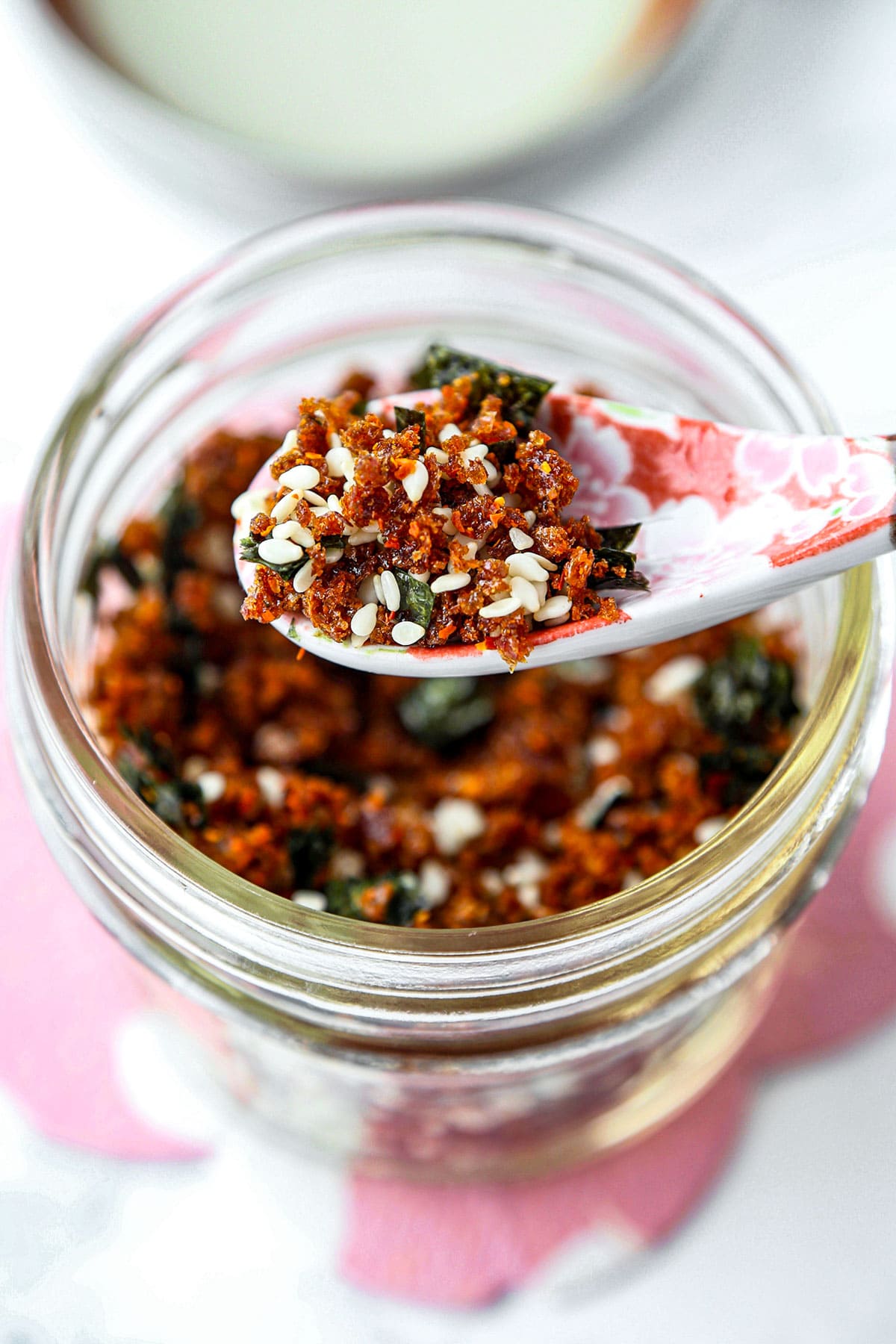
Furikake was one of those ingredients I could always find in our pantry growing up because my mother ate rice almost every single day (she still does). Being far away from her home country meant that she often felt lonely, out of place culturally and linguistically, and looked for ways to soothe her homesickness. Having a bowl of Japanese white rice was a way to feel connected to Japan and something to look forward to on a daily basis. Sometimes she had rice with tsukemono (Japanese pickles), and other times she liked to shake a small packet of furikake over the rice to season it.
I fell in love instantly the first time I had it. The savory, sweet, earthy, and nutty flavors of furikake complemented the delicate sweetness of the rice so beautifully that I covered my rice with several packets! Furikake is a Japanese seasoning made primarily of dried bonito flakes, seaweed, sesame seeds, and simple pantry spices. It’s savory, slightly sweet, earthy, and nutty. It’s usually sold in small packets and comes in various flavors. It’s a very popular seasoning in Japan where it’s used not only for bowls of rice, but for other dishes such as onigiri, okayu, breaded chicken, and toasts.
These days furikake can be found in many Asian grocery stores across the country or purchased online. But I like to make my own since it’s so easy to make from scratch. My furikake recipe only requires seven ingredients and takes about 15 to minutes to make.
Table of contents
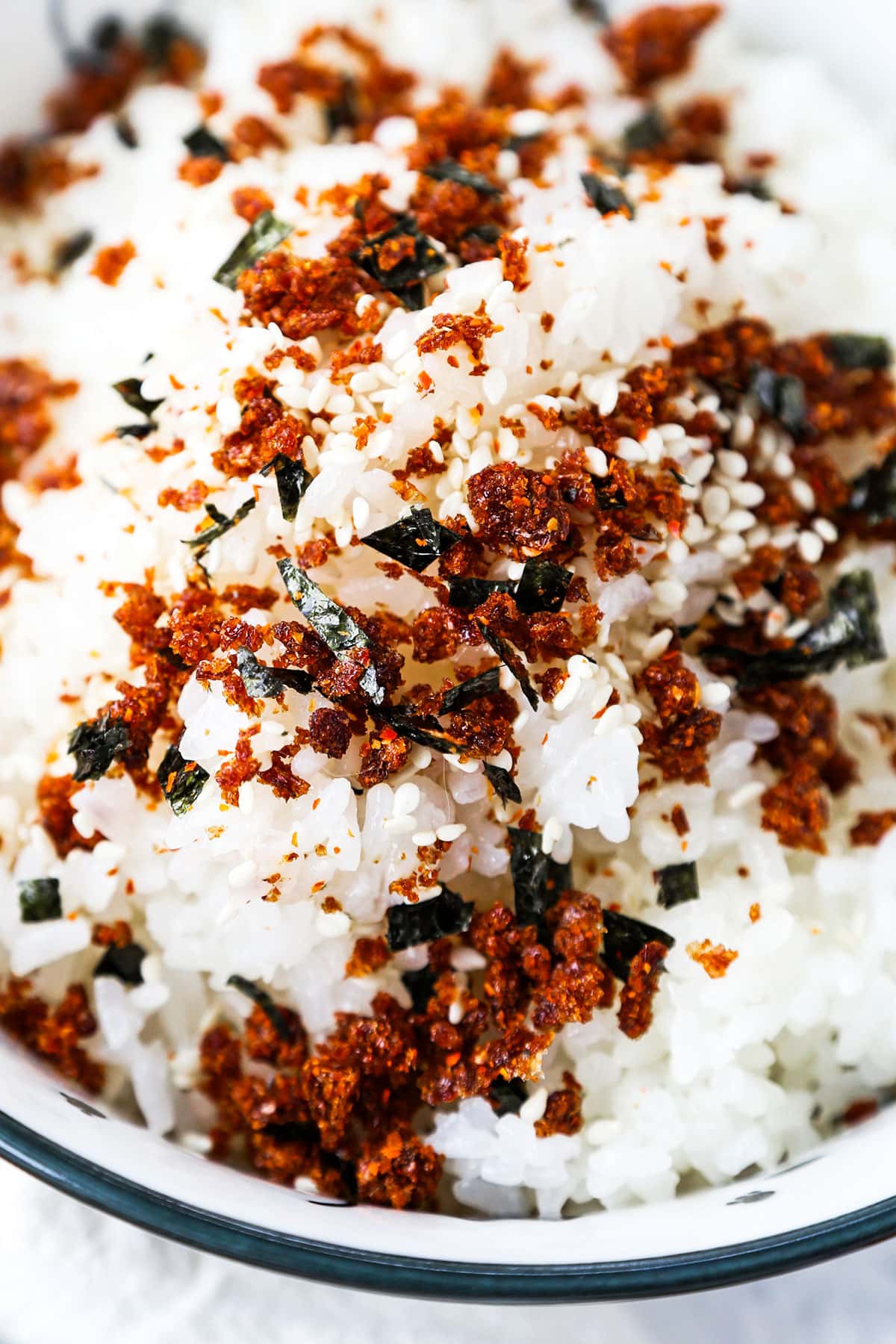
Ingredients
- Bonito Flakes: Katsuobushi (かつおぶし) is made of smoked bonito or skipjack tuna, fermented and dried into hard blocks. Those blocks are then shaved, producing thin ribbons of dried fish flakes. If the bonito flakes are large, you’ll want to crush them in the palm of your hands to break it into smaller pieces. If you’re getting to the bottom of the bag, the smaller (almost dust-like) bits work the best.
- Soy Sauce: You’ll need only about 2 teaspoons of regular Japanese soy sauce for this recipe.
- Sugar: You can use brown or white sugar for the furikake. It will add a bit of sweetness around the edges to counter the more savory ingredients.
- Sesame Oil and Sesame Seeds: Both are used to add an element of nuttiness. The sesame oil imparts a nutty fragrance and flavor throughout the dish while the sesame seeds add a lovely crunch.
- Nori: Nori is seaweed that has been dried and pressed into thin sheets. Scissors or a knife are used to cut the nori into small pieces.
- Ichimi or Shichimi: Ichimi Togarashi is simply ground red chili pepper. Using ichimi will add heat to the furikake. Shichimi Togarashi is a blend of red chilis, shiso leaves, nori powder, orange peel, ginger, poppy seeds and sesame seeds. It will also add a little heat but some aromatics as well. Both of these ingredients are optional.
Variations
When it comes to furikake, the main thing to remember is that dry ingredients are most often used to make the seasoning more intense in flavor and last longer. However, I like to add fresh ingredients to it if I know I will be using the entire seasoning in one meal. Here are some ways to play with the textures and flavors for a different furikake experience:
- Dry ingredients: To make furikake smoky, add 1/2 teaspoon gochugaru to the mix. To give it an herbal lift, add 1/2 teaspoon of dried parsley or basil. To give it an eggy flavor, break up 1 or 2 fully cooked egg yolks. Crush 1/4 cup salt flavored potato chips for a Western twist.
- Wet ingredients: Keep in mind that using wet ingredients means the furikake will only be good to use for 1 or 2 days, tops. Shred a small salmon fillet for a more intense fish flavor. Finely chop 1/4 cup of pickled mustard greens and pat dry with paper towels. This will give the furikake a tangy and slightly spicy taste. Mince 1 or 2 Thai chilis for a very hot furikake.
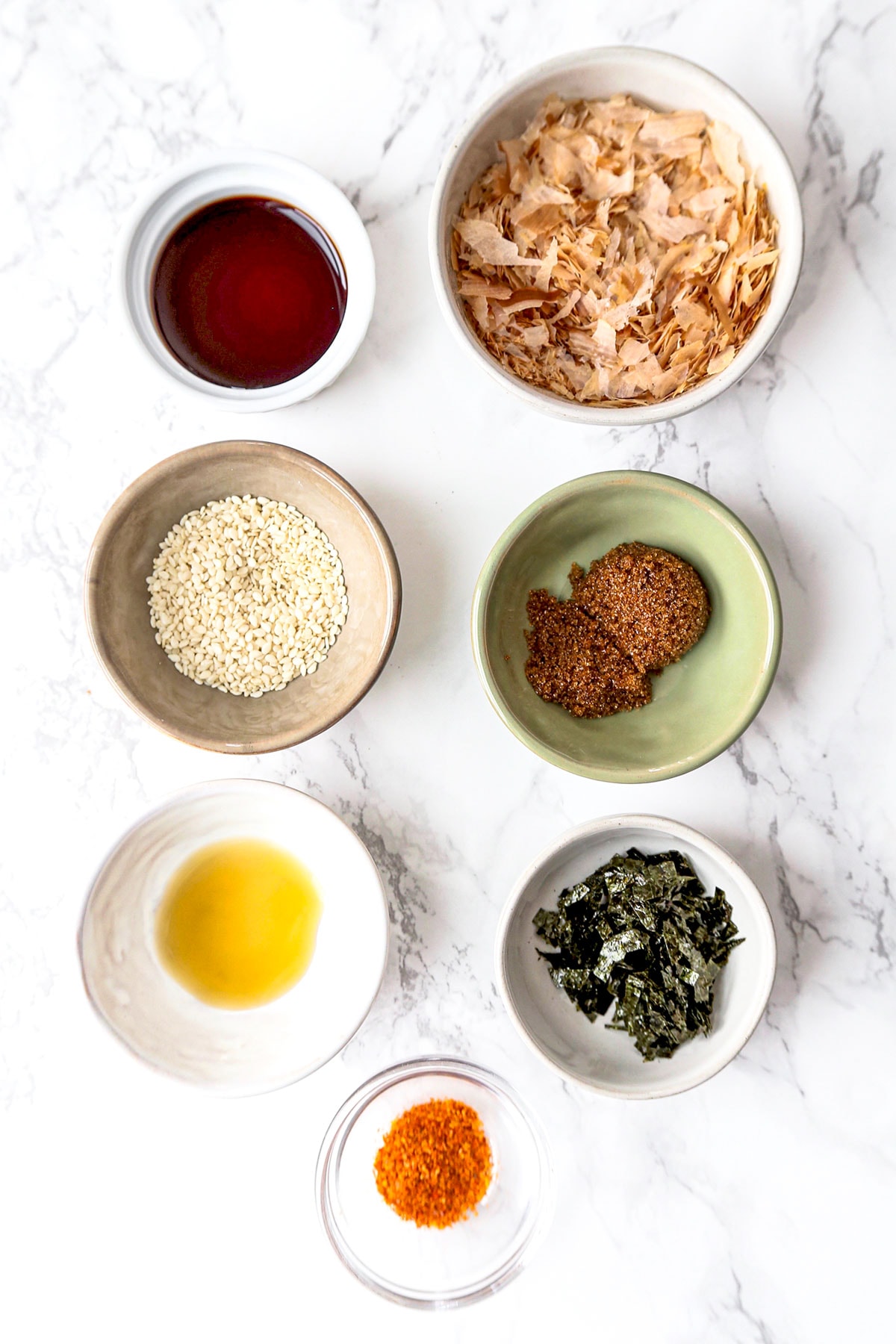
How To Make It
- Add the bonito flakes, soy sauce and sugar in a skillet over low heat. Stir for about 5 minutes, until the mixture is sticky and resembles brown sugar.
- Stir in the sesame oil and coat the mixture evenly. Turn the heat off.
- Transfer the mixture to a cooking pan and let it cool to room temperature. Break the mixture with your fingers into crumbs and transfer to a bowl.
- Add the sesame seeds, nori, and ichimi, and stir to combine.
- Sprinkle the mixture over Japanese rice and serve.
Expert Tips
- Same texture: The closer in size all of the ingredients are, the better the furikake. Furikake is meant to be sprinkled on top of rice so the ingredients should fall evenly and delicately.
- Taking time to cook the bonito flakes: You may need more or less time to cook your bonito flakes than what the recipe says. Every burner is different so it’s better to focus on the texture of the flakes – they should be very sticky and clumpy when they come out of the skillet – than the timing.

Storage
Place the furikake in a glass jar or other storage container with a lid. Refrigerate for up to 2 weeks. Some people say that adding a food safe silica gel desiccant packet and keeping it in an airtight jar can extend the life of furikake by up to 5 months. I haven’t tried it so I cannot confirm that this statement is correct. If you have tried it, please let me know in the comment section!
Freezing: Furikake can be frozen! Simply transfer it to an airtight container or storage bag and freeze for 1 to 2 months.
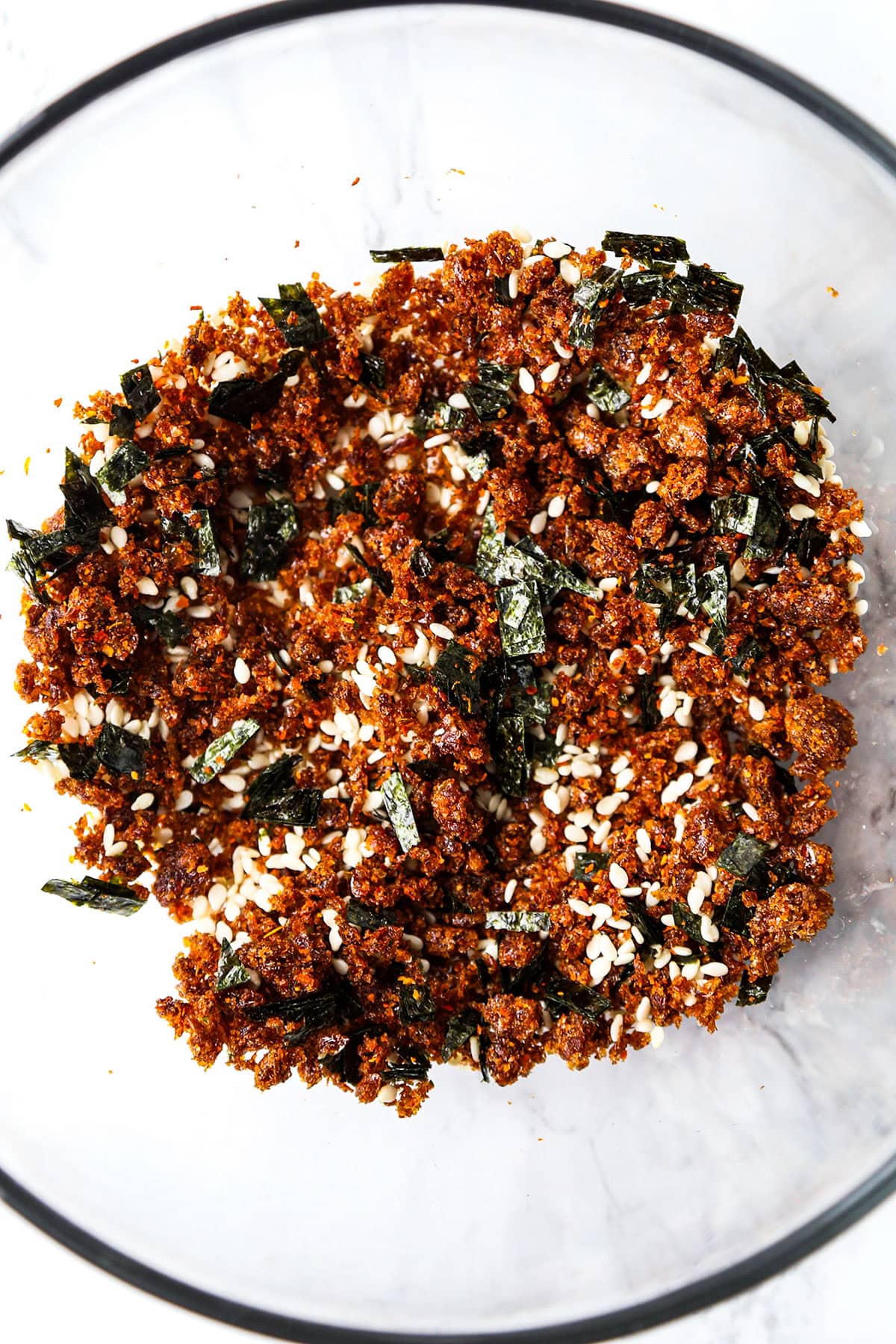
How To Use Furikake
As I mentioned, furikake is most commonly served on top of cooked Japanese rice. However, there are a ton of delicious ways to use furikake with your favorite foods. Here are some of my favorites:
- Salad: The texture and flavor can transform a simple green salad or potato salad into a wonderful thing indeed! Sprinkle furikake on top after you dress your salad. This way the dressing won’t blunt the crunch.
- Popcorn: Make movie night even more special. If you’re having a tough time getting your furikake to stick to the kernels, toss your popcorn with a tiny bit of olive oil or canola oil, then toss the popcorn with this awesome Japanese seasoning. YUM!
- Breaded Chicken: The mix of umami, nuttiness, and sweetness will elevate a crispy piece of breaded chicken to master chef levels.
- Pasta: Try it on spaghetti vongole. I promise fireworks!
- French Fries: See my recipe for furikake fries. They are absolutely delicious!
- Poke: This delicious fish and rice bowl is already perfect but in Hawaii, adding a shake or two of furikake is an option at poke meccas like Foodland Farms.
Frequently Asked Questions
Yes you can! Simply swap regular soy sauce for gluten-free soy sauce, tamari, or liquid aminos.
Yes it can but it will not taste the same as the original recipe. The flavor of bonito flakes is what makes the dish so special because they impart a lot of depth of flavor, and the traditional Japanese element. I have seen some Japanese recipes using ground almonds or ground oats instead of bonito flakes to make this seasoning.

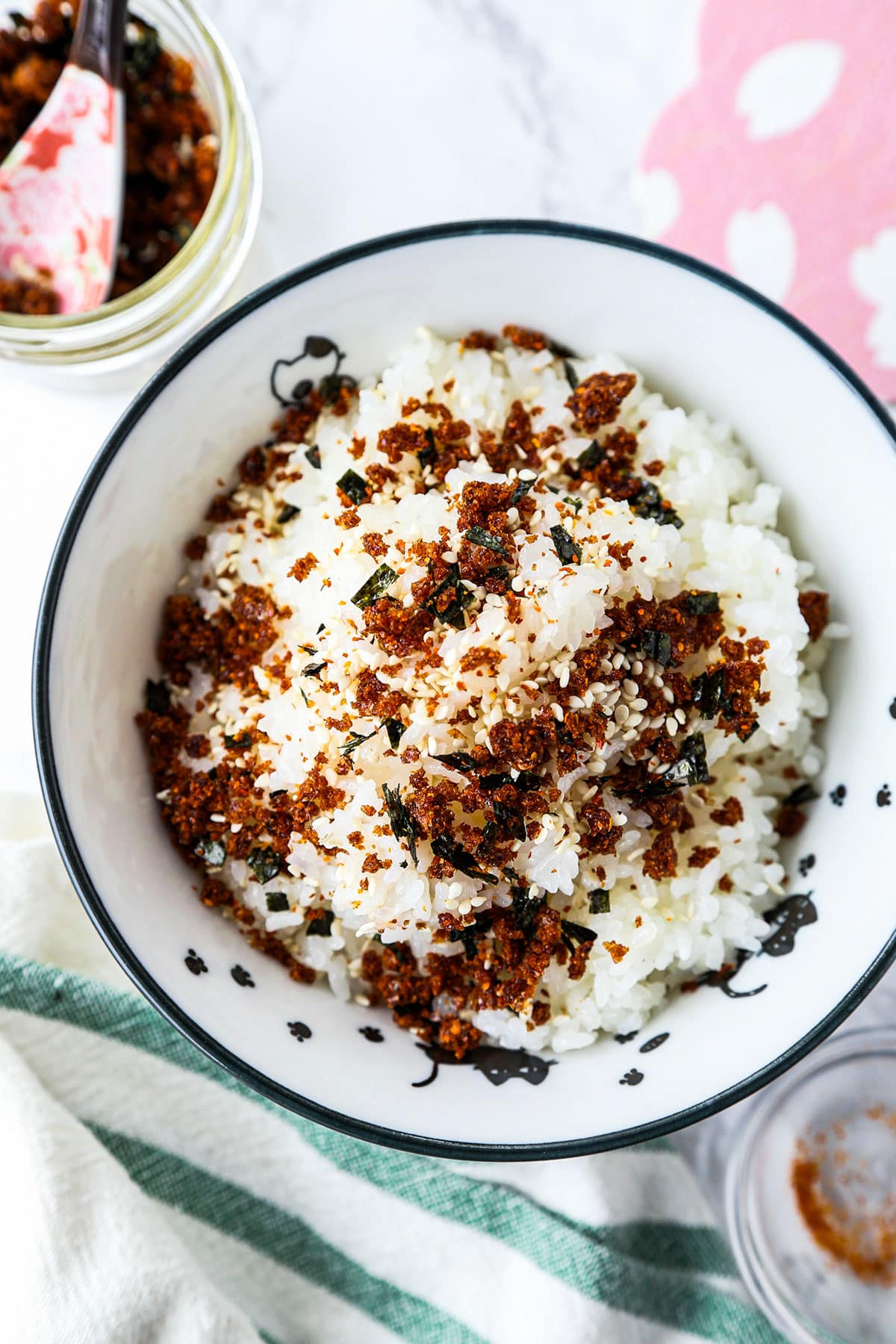
Did you like this recipe? Are there changes you made that you would like to share? Share your tips and recommendations in the comments section below.
Print
Furikake – Japanese Rice Seasoning
- Prep Time: 10 minutes
- Cook Time: 5 minutes
- Total Time: 15 minutes
- Yield: 1/4 cup 1x
- Category: Seasoning
- Method: Mixed
- Cuisine: Japanese
- Diet: Low Calorie
Description
Use this all purpose Japanese seasoning on cooked rice – or on anything that needs a little umami crunch!
Ingredients
- 1/2 heaping cup bonito flakes (katsuobushi), crushed into small pieces
- 2 teaspoons soy sauce
- 2 teaspoons sugar
- 1/2 teaspoon sesame oil
- 2 tablespoons sesame seeds
- 1 1/2 tablespoon nori, cut into small pieces
- 1/4 teaspoon ichimi or shichimi powder (optional)
Instructions
- Season and pan fry the bonito flakes: In a pan over low heat, add bonito flakes, soy sauce and sugar and cook, stirring constantly for about 5 minutes – until the mixture is sticky and almost looks like brown sugar. Add in sesame oil and stir to coat the mixture evenly. Turn the heat off.
- Cool the mixture: Transfer to a sheet pan and let it cool to room temperature. Break the mixture with your fingers into small granules and transfer to a bowl.
- Make the furikake: Stir in sesame seeds, nori and shichimi.
- Serve: Sprinkle the mixture over cooked Japanese rice and serve.
Notes
When cooking, use a non-stick pan to prevent the bonito flakes from sticking and burning.
Nutrition
- Serving Size: 1 tablespoon
- Calories: 46
- Sugar: 2.3g
- Sodium: 171.8mg
- Fat: 2.8g
- Saturated Fat: 0.4g
- Unsaturated Fat: 1.2g
- Trans Fat: 0g
- Carbohydrates: 3.7g
- Fiber: 0.6g
- Protein: 2g
- Cholesterol: 2.1mg















Can you give me a weigh in grams for the Bonito flakes? Half a cup of flakes, crushed gives me a bit more than a tablespoon, half a cup of crushed flakes is almost half the 80 g bag. I’m not sure how much I should be using!
Hi Janet! I don’t how many grams it comes to since the recipe doesn’t have to be exact. But using about half of the bag seems about right. I use about 1/2 cup of bonito flakes, packed in, and crush the flakes after. I hope you enjoy the recipe! 🙂
This is by far the BEST Furikake recipe! Thanks for sharing. You won’t be disappointed if you try it!
Thank you for this recipe! Some of the commercial varieties have additives that one may not want. I also read somewhere that you can bake (leftover) shrimp tails and crush them to add to the mix.
Thanks now I don’t have to buy it in the stores, which we don’t have in tennessee. Just need to find bonito flakes. Thanks for posting this recipe
Caroline,
Thanks for writing up this nice post. Great to tie your Mom into the genesis of your making this. Good descriptions and backgrounds. Stopping at Berry Farms in Hopewell Junction tomorrow to pick up ingredients and then, in the words of Jackie Gleason, Away we go!
How long can you keep it and do you have to store it in the fridge?thank you
Hi Isabelle! If I know I’m going to eat it in the next few days, I leave it in my pantry in a glass jar. Otherwise, I recommend refrigerating it, it should keep for about a month.